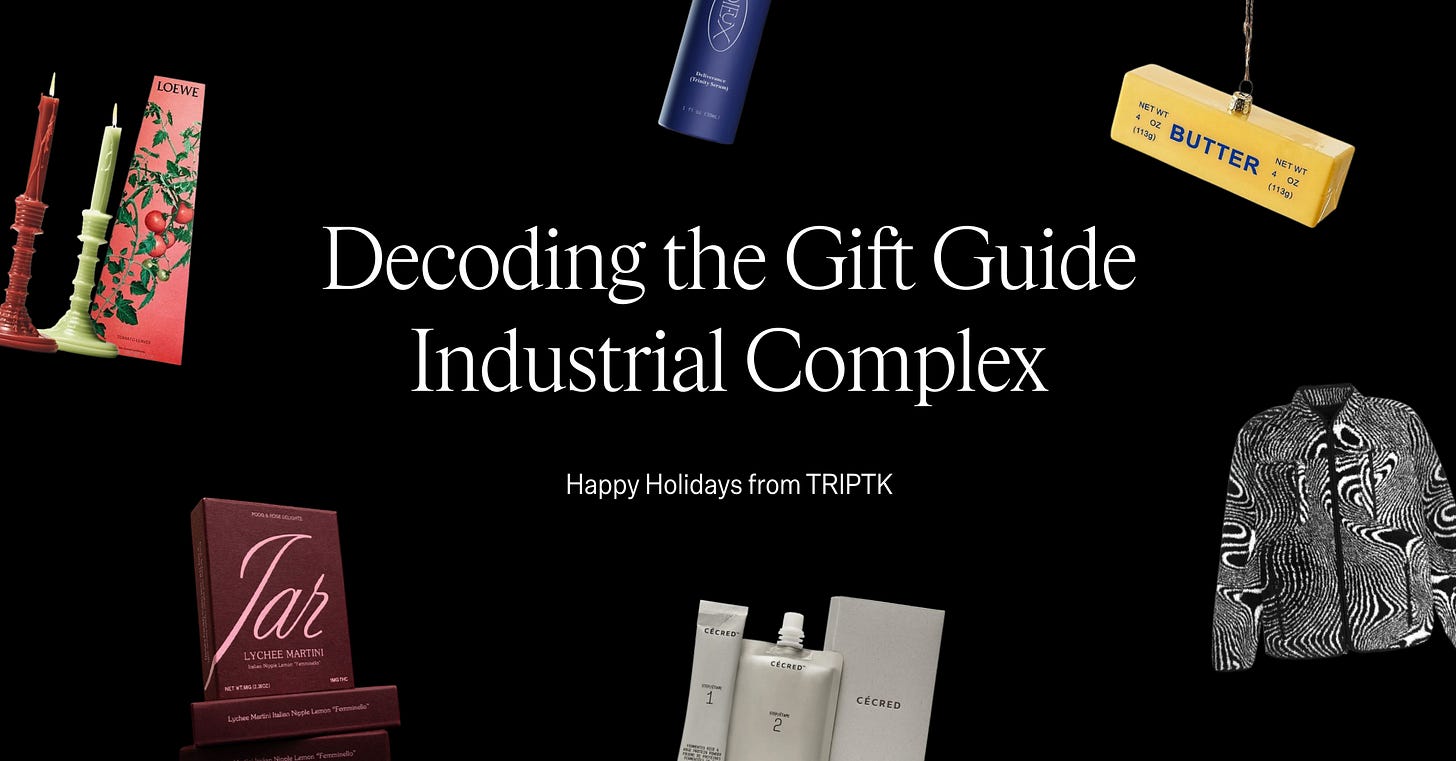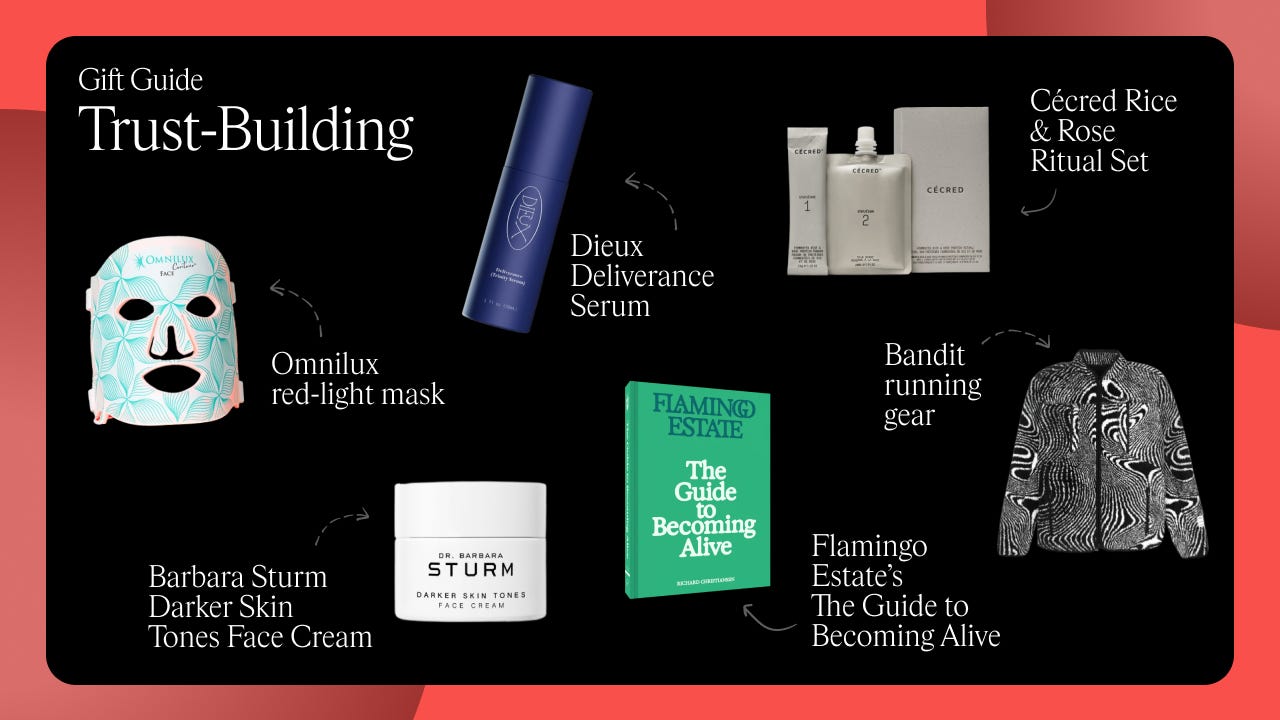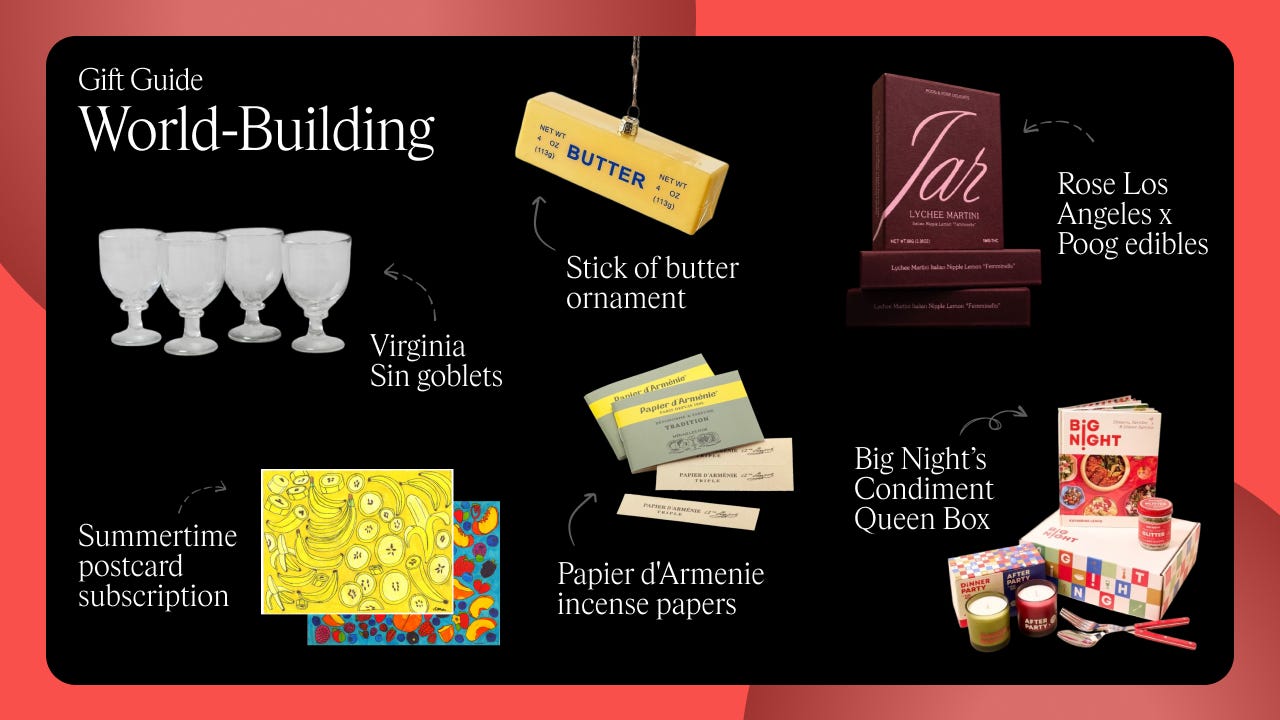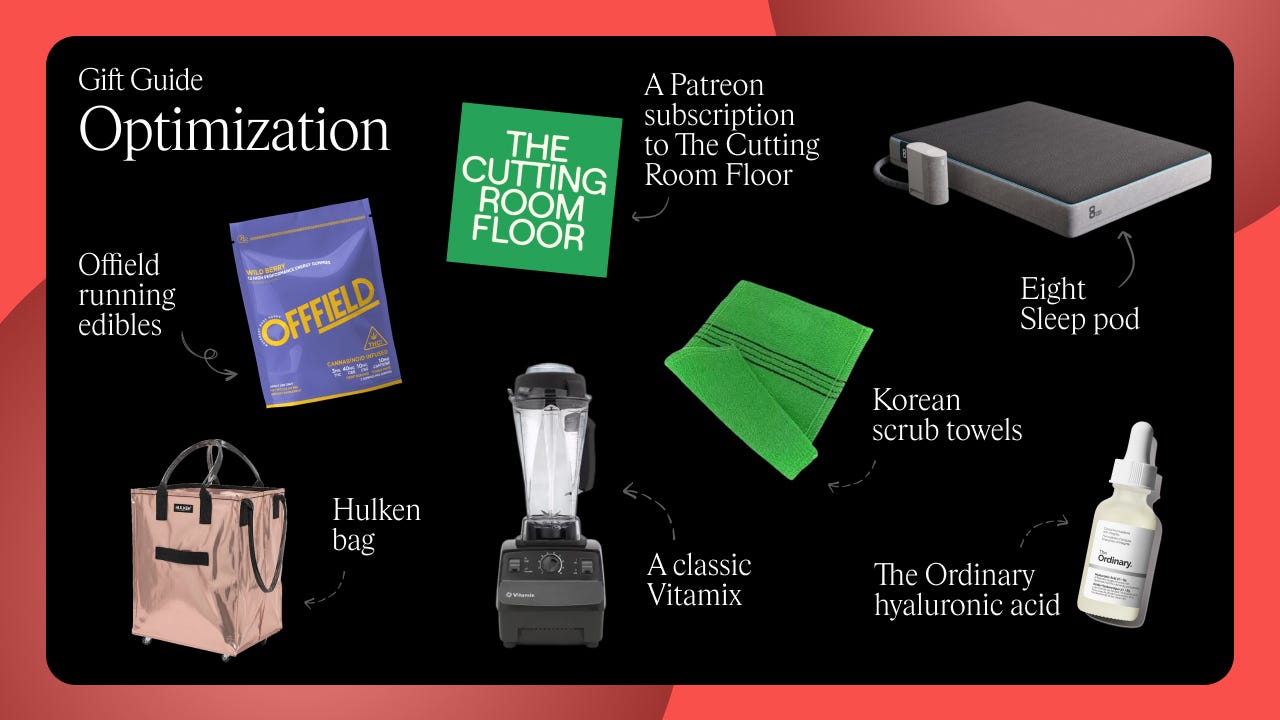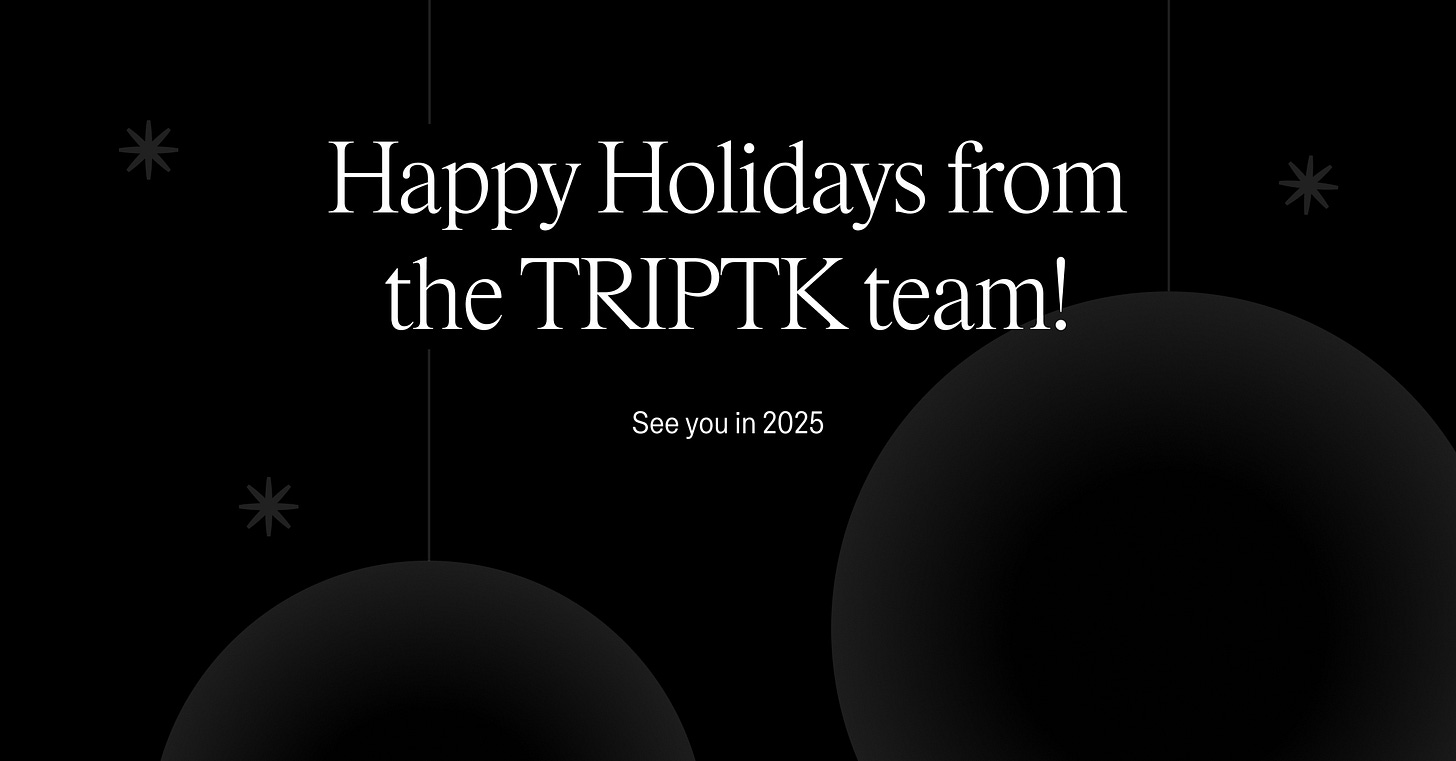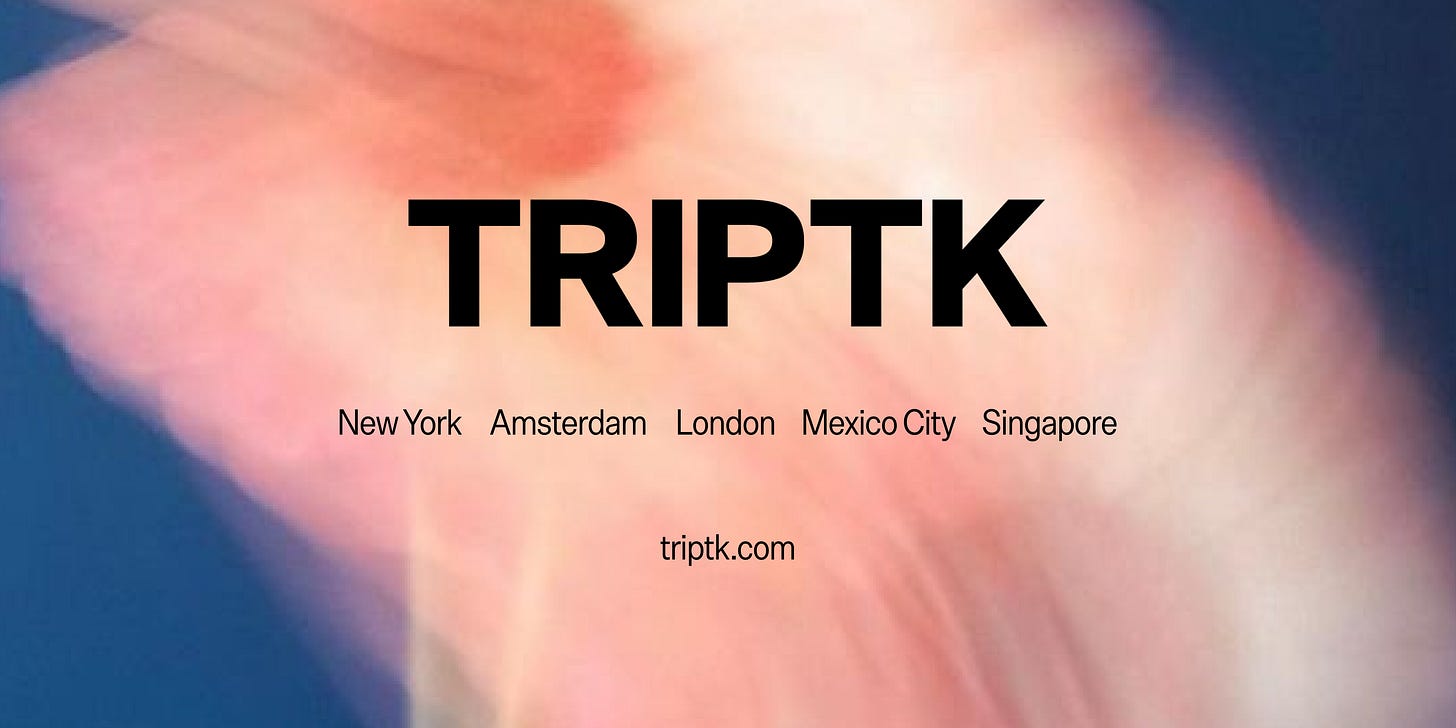Decoding the Gift Guide Industrial Complex (plus Maggie's Gift Guide)
What makes any gift good?
Each issue of Codex, written by a different member of the TRIPTK team, digs into the ephemera, artifacts, case studies, and conversations most interesting to them at the moment.
It’s for readers who want to give more to culture: to contribute vs. appropriate, embed vs. watch from afar, lead vs. follow. Join us for the ride.


Decoding the gift guide industrial complex
I simply love a gift guide! And these days, my inbox is absolutely full of them: beautiful, chic, successful people telling me what other beautiful, chic, successful people want. My obsession with the gift guide certainly started with the Hammacher Schlemmer catalog: a portal to a time and place where a kid could receive a pirate ship playhouse or a life-size T-Rex skeleton by mail.
The gifts that filled its pages were vaguely useful, hyper-specific, and sometimes physically enormous—not brand-name status symbols that you could show off in the cafeteria, but stuff a Disney protagonist could only dream of.
Sure, I wanted what everyone else had (the light-up Skechers, the Delia’s bell bottoms). But I longed for what no one else had.
My love for unearthing unexpected treasures became a career: as an editorial assistant at BUST Magazine, I combed through Etsy pages and PR packages to curate shopping roundups.
It was an early lesson in how a powerful brand can shape culture—my association with the publication gave me the platform, and the permission, to influence thousands of shopping decisions.
If the first wave [of gift guides] was pioneered by old-school women’s media, and the second wave by online publishing upstarts, then we’ve now firmly entered a sprawling, gatekeeper-free era where virtually every person and company with even a semi-professional online presence publishes some kind of seasonal gift recommendation. (
, Links I Would Gchat)
In the great “unbundling” of recommendation media, credible tastemakers have turned their individual critical eye into cultural, and literal, currency.
For what I used to spend on an issue of Lucky (RIP), I—with thousands of other reco-heads—shell out for weekly roundups like
’s Fancy Mom Gift Guide, ’s tiny, beautiful treats, Brooke Devard’s skincare rundowns, and ’s crowdsourced Amazon curation.Recoding our approach to gift giving
As taste-making has become more individualized (and IMO, more exciting), the thrill of the hunt has turned meta. A personal brand both feeds, and is fed by, recommendations—and who recommends the recommenders?
Because I work in brand strategy, I felt compelled to dissect the gift-guide ecosystem into four territories:
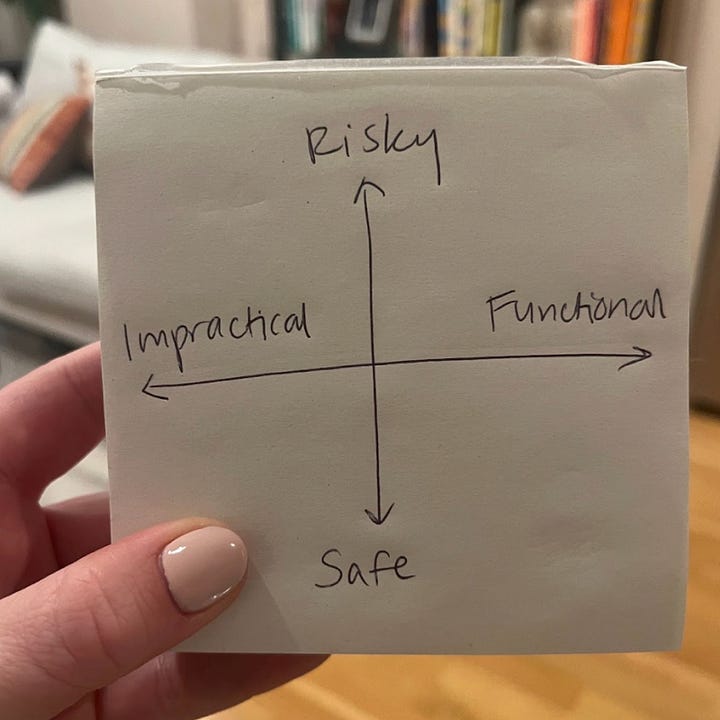

And because I love a gift guide, I decided to curate a gift guide for each potential recommendation territory. (You can take the girl out of print media…). Enjoy!
Recommendation as reasonable risk
‘Little treat’ culture has been classified as a response to global existential grief and boredom, concerning therapists and perplexing boomers for almost a decade.
A reasonably risky recommendation is the quintessential little (or big) treat: emotionally and sensorially satisfying and an objectively insane financial decision.
Examples (as seen above) include Le Labo laundry detergent, a rather lovely Loewe candle, these Hermes dominoes, LV chocolate (naturally), The Row house slippers, Alessi x Virgil Abloh flatware, or a reasonably priced Goodland wood-fired hot tub.
Recommendation as trust-building
It’s hard to trust a platform or a human when up to 15% of e-comm reviews are AI-generated and Amazon influencers are warring over IP.
Trust-building recommendations de-risk complex, functional purchases with deep research and bold personality—like Dieux founder Charlotte Palermino, who flexes her deep knowledge and (sometimes) controversial opinions on the beauty and skincare industry to build credibility for her own brand.
Examples (as seen above) include a Omnilux red-light mask, Dieux Deliverance Serum (yes), the Barbara Sturm Darker Skin Tones Face Cream, some Bandit running gear, Flamingo Estate’s The Guide to Becoming Alive, or a Cécred Rice & Rose Ritual Set.
Recommendation as world-building
World-building recommendations are impractical but safe: beautiful art, charming knick-knacks, aesthetically pleasing basics, and small delights.
Shoppy shops and boutiques are deeply influential in world-building recommendations—context like display, scent, and color make each gift a portal to a new identity and vibe.
Examples (as seen above) include a Summertime postcard subscription, Big Night’s Condiment Queen Box, a few lovely boxes of Papier d'Armenie incense papers, the Virginia Sin goblets, Rose Los Angeles x Poog edibles, or perhaps most notably, a stick of butter ornament.
Recommendation as optimization
Optimization recommendations are a very good version of a thing you’ll use every day.
They oppose ‘haul’ culture—buy once, cry once is the motto—and optimization gifts’ aura of effectiveness only grows when hidden from public view, under a bed or behind a cabinet. This is the ‘how did I live before this’ gift—and the one I personally take the most joy in recommending.
Examples (as seen above) include a few Korean scrub towels, a Patreon subscription to The Cutting Room Floor (congratulations), a classic Vitamix, a Hulken bag, Offield running edibles for your next workout, an Eight Sleep pod, and The Ordinary hyaluronic acid.
Links shared this month in Slack / over text / in decks
Who’s Laughing Now? Banana-as-Art Sells for $6.2 Million at Sotheby’s: “[The artwork was just] a fruit-stand banana taped on the wall. But 7 bidders were biting. It went to a crypto entrepreneur.”
Elizabeth Goodspeed on untangling credit in design: “Credit or not, the rebrand cycle rolls on. In a field built on evolution, the only real credit comes from whatever you do next.”
‘Everybody Is Drinking Guinness.’ We Know Why: “Guinness, once synonymous with old Irish pubs and old Irish men, is increasingly winning over younger, beer-bent Americans like Mr. Quinn. ‘It’s having a moment,’ he said.”
The Role of Innovation in the Future of the CPG Industry: “In May 2024, almost a third (31%) of US adults admitted to buying more store brands over the past two months. Will those consumers automatically return to big brands once they feel more financially confident?” (h/t Havas GLP-1 Consultancy)
What we’re refusing to talk about
What we’re grateful for (always)
Codex has been in the works since early this year, and we’re so happy that it’s getting such enthusiastic reception from this community. Thank you for reading and for passing it along. We really, really mean it. We’ll be back in January with our first hot take of 2025. Until then, stay safe, stay kind, and stay curious!
About TRIPTK & Codex
TRIPTK is a brand & innovation consultancy. We partner with leaders to decode and recode critical cultural shifts, creating brand value for today and tomorrow.
Codex is a monthly newsletter sharing the TRIPTK perspective. It’s for readers who want to give more to culture: to contribute vs. appropriate, embed vs. watch from afar, lead vs. follow.
Subscribe to never miss an issue. Opt out (below) at any time.
Any outsized opinions expressed here are solely the author’s and do not represent the opinion of the company. If you like this newsletter, consider subscribing – or sharing with others who might enjoy it. Feel free to comment, email, say hey, and/or send us things to read.



